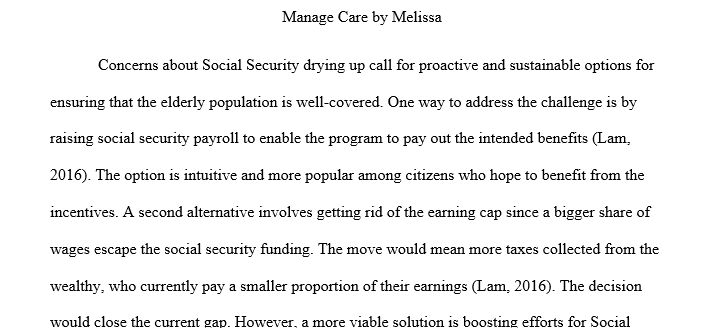DRG or disease-related groups and RUG or resource utilization group are ways to classify a patient. DRG is used for classifying the type of
Response shared by Melissa Tubbs
2
Medicare
History has recognized that accidents in the workplace are inevitable and injuries result from these accidents that leave workers unable to perform their duties. This led to the creation of a sickness fund that existed in some form since the Civil War. The idea behind it was to provide injured/sick laborers with money if they could not work. Other members would contribute to this fund collectively. While this wasn’t actual health insurance but more of disability insurance. The concept of paying for health care was borne out of Baylor University Hospitals need to generate income post-Depression Era by creating a system for people to pay for hospital care. Under the Baylor Plan, public school teachers would have 50 cents taken from their pay each month and if hospitalization was needed, the first 21 days would already be paid for. This would evolve into the development of the American Hospital Association Blue Cross Commission in 1946. In the decades following there were rapid developments in health insurance companies and plans. After WWII, President Truman worked to focus more on domestic issues and national health insurance was part of this agenda. This evolved into obtaining medical care for the elderly because even though Social Security had already been created, it did not provide health insurance coverage for the elderly. The Kerr-Mills Act of 1960 provided federal funding to create a health insurance program for the elderly that were receiving welfare funds. Thus, Medicare was born. It was not that simple. By basing eligibility for Medicare solely on Social Security guaranteed that wealthy members of labor unions benefited while the lower wage working members paid for it through payroll taxes. Instead of eliminating the program completely, Representative John Byrnes of Wisconsin proposed what is now known as Medicare Part B and worked to provide physician and ambulatory services to seniors funded by general tax revenues and premiums paid by seniors. Medicare Part B became a need basis and provided allocations for nursing home care as well. (1) Medicare today offers managed care plans which allow enrollees to choose a plan that will serve them best if they wish. There are HMO, PPO, private fee-for-service, and special needs plans. These plans are offered by private companies that are overseen by medicare and are required to offer all that medicare does and then some.
Eligibility for Medicare includes the following: over the age of 65, disabled and receiving SSDI, or having end-stage renal disease or AML (Lou Gehrig’s disease) (2) Distribution of Medicare in 2017 is demonstrated in the figure below. (3)
The various population types receiving medicare in 2017 are demonstrated in the following figure: (3)
DRG or disease-related groups and RUG or resource utilization group are ways to classify a patient. DRG is used for classifying the type of care a patient has received during a hospital stay in an attempt to obtain payment. (4) RUG is utilized by skilled nursing home facilities. (5) Both systems legitimize payment based on the level of care they provide to a patient or resident. It stands to reason that the more care a patient/resident requires, therefore, the facility requires a higher level of reimbursement.
Question for class: With so much discussion for decades of Social Security drying up, how should we as a nation fund such a program knowing that our elderly population is only going to increase as the years go on? Is Medicare managed care a sufficient option?
Morrisey, M. A. (2020) Health Insurance. Third Edition. Health Administration Press.
Behring, S. Understanding Medicare Managed Care Plans. (2020) https://www.healthline.com/health/medicare/medicare-managed-care#eligibility Reviewed by Biggers MD, MPH. A
An Overview of Medicare. https://www.kff.org/medicare/issue-brief/an-overview-of-medicare/ Published February 2019.
https://www.cms.gov/icd10m/version37-fullcode-cms/fullcode_cms/Design_and_development_of_the_Diagnosis_Related_Group_(DRGs).pdf
https://www.healthpro-heritage.com/blog/bid/115404/Your-skilled-nursing-home-facility-and-new-Rug-IV-refinements-PART-1#:~:text=RUG%20(Resource%20Utilization%20Groups)%20is,their%20care%20and%20resource%20needs.
Answer preview for DRG or disease-related groups and RUG or resource utilization group are ways to classify a patient. DRG is used for classifying the type of

APA
290 Words